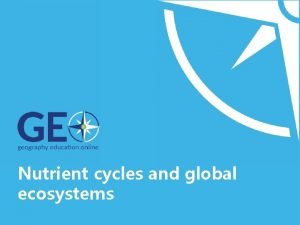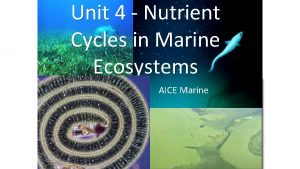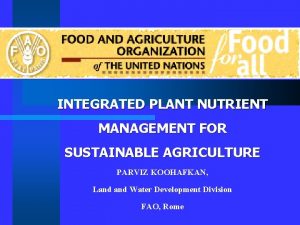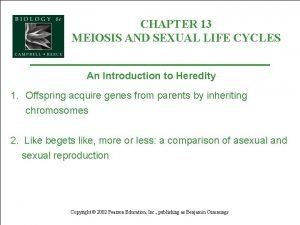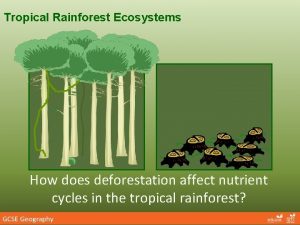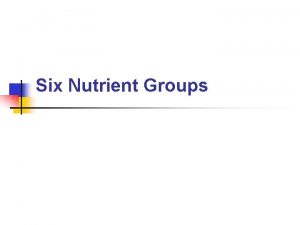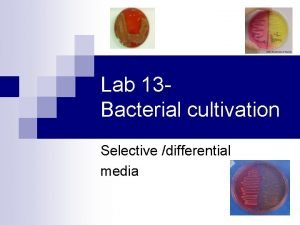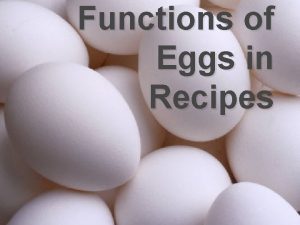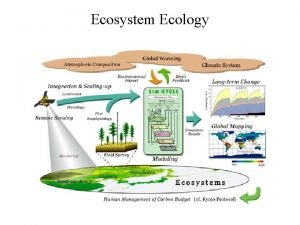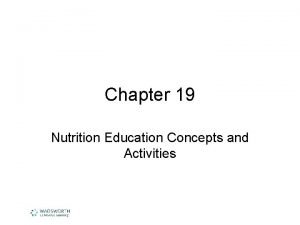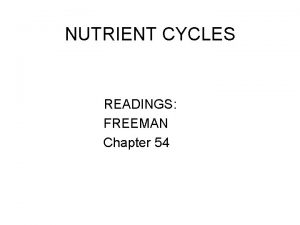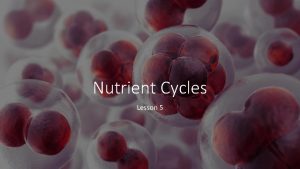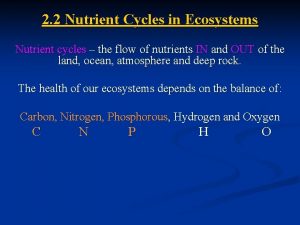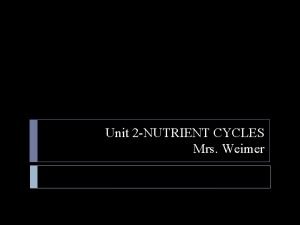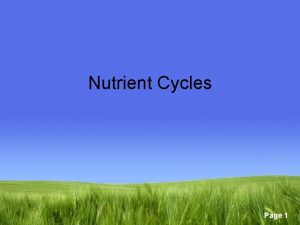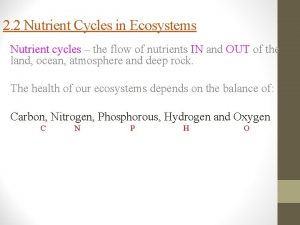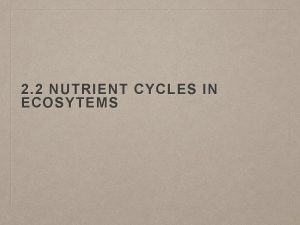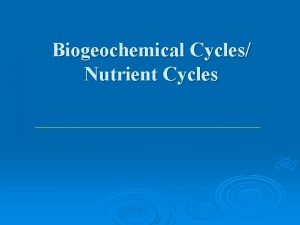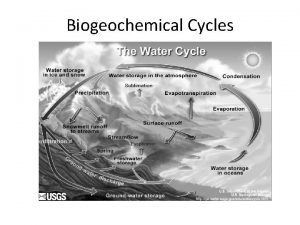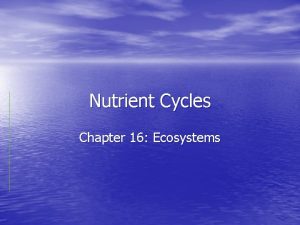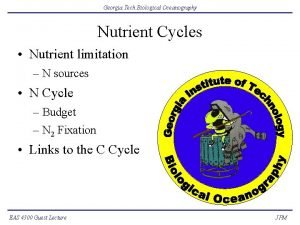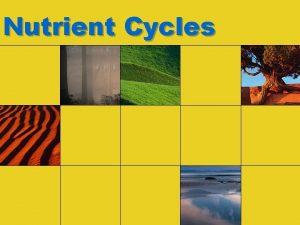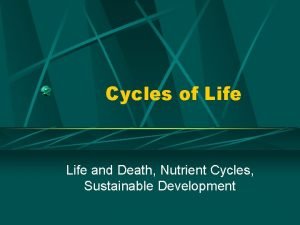Agriculture and Nutrient Cycles Chapter 2 7 Agriculture















- Slides: 15

Agriculture and Nutrient Cycles Chapter 2. 7

Agriculture and Nutrient Cycles • The seeds, leaves, flowers and fruits of plants all contain valuable nutrients. • As crops are harvested, the valuable nitrogen and phosphorus are removed and do not return to the field. • This diversion of nitrates and phosphate from the local cycles would soon deplete the soil unless the farmer replaced the missing nutrients.

• Nutrients are chemicals required for growth and other life processes. • Nutrients move through the biosphere in nutrient cycles or exchanges • Nutrients cycles are the flow of nutrients in and out of the land, ocean, atmosphere and deep rock

• The health of our ecosystems depends on the balance of the five chemical elements that are required for life: – Carbon (C) – Nitrogen (N) – Phosphorus (P) – Hydrogen (H) – Oxygen (O)

• C, H, O and N between living things and the atmosphere. • P cycles between living things and sedimentary rocks. • Without interference, generally the amount of nutrients flowing into a “store” equals the amount of nutrients flowing out

• Human activities can upset the natural balance of nutrient cycles. – Land clearing, agriculture, urban expansion, mining, industry, and motorized transportation can all increase the levels of nutrients more quickly than the “stores” can absorb them.

• In agriculture, when crops are planted, they take in nutrients from the soil and use them to grow. As crops are harvested and taken from the fields, valuable nutrients (such as nitrates and phosphates) are removed and prevented from being returned to the soil (naturally) • This diversion of nutrients from the local cycles would soon deplete the soil unless the farmer replaced them.

• Fertilizers are materials used to restore soil nutrients and increase production from the land. • However, adding too much fertilizer is not a good idea. • Extra, unused fertilizer can end up in streams and lakes.

Reading a Fertilizer Label • A fertilizer label will have 3 numbers, for example: 40 – 10 – 20 15 – 15 • These numbers correspond to the percentage of the fertilizer that is nitrogen (N), phosphorus (P) and potassium (K) “N – P – K”

Reading the Label • N – Nitrogen – promotes new green growth above the ground. If a plant has plenty of nitrogen it will grow quickly and have rich green foliage – Note: If fertilizing a lawn, nitrogen should be highest • P – Phosphorus – helps a plant produce strong roots and helps with flower production – Note: Increases blooms on flower

• K – Potassium – Is needed for growing strong plants. They are less susceptible to disease, to damage from the cold, and are more protected from excessive moisture loss during dry spells. Potassium is good for overall healthy growth. – Note: Improves overall health of flora

Fertilizer and Ecosystems • Read page 70 -71 in text. • Q 1. What is an algal bloom? When does it usually occur? Describe the process that causes an algal bloom. • Answer: • Nutrients allow algae to grow rapidly ( algal bloom) • Algae die – Bacteria uses oxygen – oxygen levels drop – fish / other animals die – decomposer eat – bacteria population grows – use more oxygen.

SOLUTIONS TO QUESTIONS • Q 2 – Why do the levels of nitrogen and phosphorus in fields decline when crops are harvested? • Answer: • Because some of these nutrients are taken away in the crop

SOLUTIONS TO QUESTIONS • Q 3 – Explain how excess fertilizers might affect decomposing organisms. • ANSWER: • Excess fertilizer can seep into waterways and cause the growth of algae. When the algae die, the population of decomposers increases rapidly, causing oxygen depletion in the water.

SOLUTIONS TO QUESTIONS • Q 4 – Explain why not planting a crop and then ploughing in the fall might help a framer restore nitrogen and phosphorus levels in the soil. • ANSWER: • During the year nutrients, including nitrogen and phosphorous, accumulate in the plants that grow. If the farmer ploughs these plants under in the fall, the nutrients will help enrich the soil. This is called “green manure. ”
 Venkatraman ramakrishnan medium
Venkatraman ramakrishnan medium Biogeochemical cycles apes
Biogeochemical cycles apes Gersmehl diagrams
Gersmehl diagrams Nutrient cycles in marine ecosystems
Nutrient cycles in marine ecosystems Integrated nutrient management for sustainable agriculture
Integrated nutrient management for sustainable agriculture Chapter 13: meiosis and sexual life cycles
Chapter 13: meiosis and sexual life cycles Chapter 13 meiosis and sexual life cycles
Chapter 13 meiosis and sexual life cycles Compare and contrast carbon and nitrogen cycles
Compare and contrast carbon and nitrogen cycles Wrist joint blood supply
Wrist joint blood supply Nutrient cycle of a tropical rainforest
Nutrient cycle of a tropical rainforest Nnn plant protein
Nnn plant protein Non fastidious definition microbiology
Non fastidious definition microbiology Emulsifier egg examples
Emulsifier egg examples Nutrient cycle in the serengeti
Nutrient cycle in the serengeti Deciduous woodlands
Deciduous woodlands Foods used in nutrition activities should be nutrient-dense
Foods used in nutrition activities should be nutrient-dense


